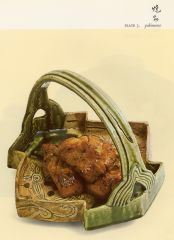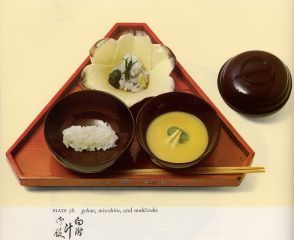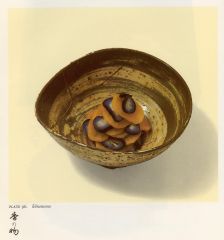Untangling My Chopsticks, by Victoria Abbott Riccardi, Broadway Books, 2003, 282pp.
A young woman goes to Japan and studies kaiseki cooking for a year. I think Susan gave this to Patricia, but I grabbed it immediately.
This is a pleasant book, earnest and readable. Victoria is not happy with her advertising job in New York, so she goes to Japan to find something different, and does. God knows, I can relate to that. It is also a great idea to include a few recipes in the book. I have not cooked any. Some are real basics, like oyako domburi, and some are more like jokes (Christmas Cake). But it did remind me that is fun to make a nest of noodles in your soup bowls, which I did shortly after reading the book, placing a few quail eggs inside as well.
There are a few pointers that I did not know, like when eating sushi, it is an insult to the chef to add wasabi to the soy sauce, since the fish should already be seasoned perfectly. But I cannot really trust any details, since Victoria's research is superficial. She blithely states that tempura is named after the temple grounds where it was sold. I had heard it derived from tempora -- the festival times when Portuguese could not eat red meat. And some etymological dictionaries say it comes from Portuguese tempero - "seasoning". All three are discussed on this Kikkoman site, which adds the fact that earliest documents show tempura as a paste of thrush meat, shrimp and ground walnuts! Vicky could have dug deeper.
Similarly she describes only a couple of Kaiseki meals, and while the symbolism is fascinating (mitsuba means "come back again"), I feel there is a lot more to be told. In fact, I wanted to hear it from Stephen. Stephen is a plump gay guy who lives in Kyoto, even thirteen years later when Victoria goes back for a visit. He is the one who translates for her in her cooking class, and he is the one who plans, organises and largely cooks and explains the kaiseki meals that Victoria helps with. I bet he has a more complex story to tell. I couldn't google anything about him, and suppose his is one of the names that Victoria changed for privacy.
Victoria makes good friends with her host family, learns a bit about Japan and goes back to New York feeling transformed. She then marries her old boyfriend, becomes a food writer, and lives happily ever after.
---
Ms Riccardi remarks that the only other significant book on kaiseki in English is Kaichi Tsuji's Kaiseki. I bought this book, which has a foreword by Yasunari Kawabata the Nobel-prizewinner, back when I lived in Japan and could barely afford it, due to the beauty of its plates, particularly number 96. I reproduce some here. Many of the bowls are borrowed from museums.

Plate3 - Tai on Oribe "pine bark flake" shaped dish, Momoyama period, Motoyashiki kiln, Mino area. |

Plate 58 - lily blossom bowl by Ninsei (mid 17th) with prawns, nori, matsubana. |

Plate 96 - brushmarked bowl, korea, Yi dynasty (hmm, anywhere in 518 years ). Takuan & eggplant. |
More recently, I bought Shunju, also for its very beautiful food pictures.

Sesame-coated green asparagus. |

Flounder carpaccio |
John wrote: She's been a judge at least twice now on Iron Chef America.
I replied: What did you think of her on TV? I wish we got Iron Chef here -- it's funny (the Japanese one). I see our rental shop doesn't have it either.
John replied: She seemed good, but remember the standards. On the original Iron Chef, the judges are daytime TV personalities and Diet members. On Iron Chef America, one of the original judges had a secondary role on The Sopranos. He was a grossly fat dees dems does kind of guy from New Jersey who, right off the bat, declared that he didn't eat raw fish. (One of the contestants that day was Morimoto, former sous chef at Nobu in New York, an Iron Chef in Japan; he how runs his eponymous restaurant in Philadelphia, where the menu is pretty much like Nobu.)
Doug wrote:
Erich, have you read Angry White Pyjamas? It's about an American in Tokyo who goes through the Tokyo Police Academy's Aikido training. I loved it.